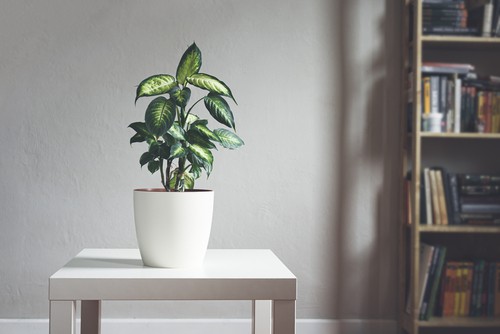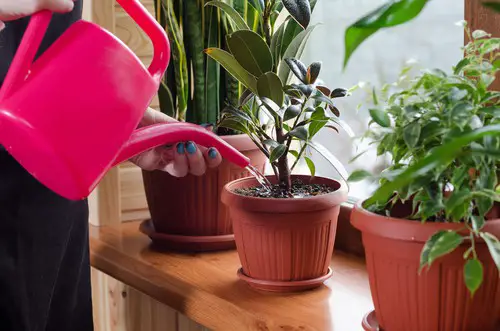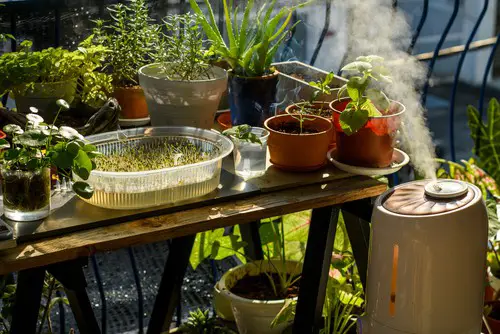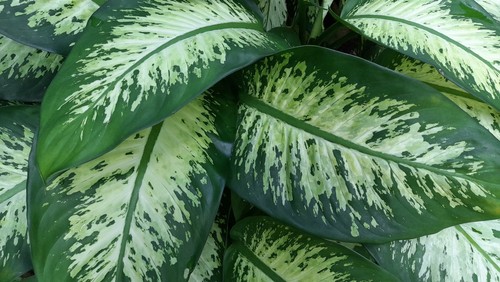Dumb Cane plants, also known as Dieffenbachia, are a popular choice for indoor plants due to their attractive foliage. However, one common issue that plant owners face is drooping leaves. This can be concerning for those who are new to plant care, but it is a problem that can be easily addressed with the right knowledge and care.
Understanding the Dumb Cane plant is important in preventing and treating drooping leaves. These plants are native to tropical regions and prefer warm, humid environments. They are also sensitive to direct sunlight and require well-draining soil.
When these conditions are not met, it can cause stress on the plant and lead to drooping leaves. In addition, overwatering or underwatering can also cause similar symptoms.
Key Takeaways on Dumb Cane Plant Drooping
- Dumb Cane plants are sensitive to their environment and require specific conditions to thrive.
- Drooping leaves in Dumb Cane plants can be caused by a variety of factors, including improper watering, lighting, and temperature.
- Preventing and treating drooping in Dumb Cane plants involves proper care and attention to their specific needs.
More posts on this category:
Understanding Dumb Cane Plant

Dumb cane, also known as Dieffenbachia, is a popular indoor plant that is valued for its lush foliage and easy care requirements. This tropical plant is native to Central and South America and can grow up to 6 feet tall. Dumb cane plants come in different varieties, with some having solid green leaves while others have variegated leaves.
Dumb cane plants are known for their ability to purify the air by removing harmful volatile organic compounds (VOCs) such as formaldehyde, benzene, and trichloroethylene. One average size dumb cane plant in a 6-inch pot can purify the air 100 feet around it, making it an excellent choice for indoor spaces.
While dumb cane plants are easy to care for, they can be sensitive to environmental changes. Dumb canes prefer bright, indirect light and thrive in temperatures between 60-75°F. They also prefer well-draining soil that is kept consistently moist but not waterlogged.
One common issue that dumb cane plants face is drooping. Dumb cane plants may begin to droop if they are not getting enough water, receiving too much bright sunlight, or if the temperature in their environment is allowed to drop too low. Whether it be from lack of water or too much hot sun, these plants don’t like to get too dry.
To revive a drooping dumb cane plant, it is important to identify the cause of the drooping and take appropriate action. If the plant is not getting enough water, increase the frequency of watering and ensure that the soil is moist but not waterlogged.
If the plant is receiving too much bright sunlight, move it to a location with lower light levels. If the temperature in the environment is too low, move the plant to a warmer location.
Dumb Cane Plant Drooping – 4 Common Problems
Dumb cane plants are tropical plants that are known for their large, lush leaves. However, sometimes these plants can start to droop, which can be a sign of an underlying problem. In this section, we will explore some of the most common causes of drooping in dumb cane plants.
1. Overwatering and Underwatering
One of the most common causes of drooping in dumb cane plants is overwatering or underwatering. Dumb cane plants prefer soil that is moist but not waterlogged. When the soil is too wet, it can cause the roots to rot, which can lead to drooping leaves.
Conversely, underwatering can also cause a dumb cane plant to droop. If the soil is too dry, the plant will not be able to absorb enough water to support its leaves.
To prevent overwatering or underwatering, it is important to water your dumb cane plant only when the top inch of soil is dry. You should also make sure that the pot has good drainage so that excess water can drain away.
2. Pest Infestation

Pests such as spider mites, mealybugs, and aphids can also cause your dumb cane plant to droop. These pests feed on the plant’s sap, causing damage to the leaves and stem. To get rid of pests, you can use insecticidal soap or neem oil to treat your plant. Make sure to follow the instructions carefully and repeat the treatment as necessary.
3. Temperature Shock
Dumb cane plants are sensitive to temperature changes, and sudden drops in temperature can cause the plant to droop. For example, placing a dumb cane plant near a drafty window or an air conditioning unit can cause the plant to become stressed and droop.
To prevent temperature shock, it is important to keep your dumb cane plant in a stable environment with consistent temperatures.
4. Lighting Conditions
Dumb cane plants prefer bright, indirect light. Too much direct sunlight can cause the leaves to become scorched and droop. On the other hand, low light levels can also cause the plant to droop. If your dumb cane plant is not getting enough light, you can move it to a brighter location or provide it with artificial light.
Symptoms of Drooping in Dumb Cane Plant
Drooping in a Dumb Cane plant is a common problem that can be caused by a variety of factors. In general, the leaves of the plant will start to droop and wilt, and this can be accompanied by other symptoms such as yellowing leaves, lower leaves falling off, and crispy or wilted leaf tips. If left untreated, the plant can become stunted and eventually die.
One of the most obvious symptoms of drooping in a Dumb Cane plant is the drooping of the leaves. The leaves will start to droop and wilt, and they may also turn yellow or brown. This can be caused by a variety of factors, including overwatering, underwatering, temperature stress, and pests.
Another symptom of drooping in a Dumb Cane plant is the falling off of the lower leaves. As the plant becomes stressed, it may start to shed its lower leaves as a way of conserving energy. This can be a sign that the plant is not getting enough water, or that it is being exposed to extreme temperatures.
In addition to drooping and yellowing leaves, a Dumb Cane plant may also exhibit other symptoms such as crispy or wilted leaf tips. This can be caused by a lack of humidity, underwatering, or exposure to direct sunlight.
If left untreated, the drooping in a Dumb Cane plant can become more severe, and the plant may become stunted. In severe cases, the plant may eventually die. Therefore, it is important to take action as soon as you notice any symptoms of drooping in your Dumb Cane plant.
Preventing and Treating Drooping in Dumb Cane Plant
Dumb Cane plants are a popular choice for indoor gardening due to their striking foliage and easy care requirements. However, one common issue that owners face is drooping leaves. Fortunately, there are several ways to prevent and treat this problem.
1. Proper Watering

One of the most common reasons for drooping leaves in Dumb Cane plants is overwatering or underwatering. To prevent this, it is important to water the plant properly. Water the plant thoroughly when the top two inches of soil become dry.
Avoid letting the soil dry out completely or sit in water, as this can lead to root rot. Additionally, use room temperature tap water or distilled water to avoid any mineral buildup.
A moisture meter can be a useful tool to ensure that the soil is at the right moisture level. If the soil is too dry, increase watering frequency. If it is too wet, allow the soil to dry out before watering again. In addition, a soil flush can help to remove any excess salts or minerals that may be affecting the plant.
2. Appropriate Light and Temperature
Dumb Cane plants thrive in bright, indirect light. Direct sunlight can scorch the leaves, while too little light can cause the plant to droop. Place the plant near a window with filtered light, or use artificial grow lights if natural light is not sufficient.
Temperature is also important for Dumb Cane plants. They prefer temperatures between 65 and 75°F, and should be kept away from cold drafts. If the plant is exposed to temperatures outside of this range, it may begin to droop.
3. Pest Control
Pests can also cause Dumb Cane plants to droop. Common pests include spider mites, mealybugs, and scale insects. To prevent these pests, regularly inspect the plant and surrounding area for signs of infestation.
If pests are present, use neem oil or insecticidal soap to control them. Be sure to follow the instructions carefully, and avoid using these products in direct sunlight or when the plant is under stress.
4. Pruning and Repotting
Pruning and repotting can also help prevent drooping in Dumb Cane plants. Trim back any yellow or wilted leaves, as these can drain the plant’s energy. Repot the plant every 2-3 years using a well-draining potting mix such as one containing perlite or vermiculite. Additionally, disinfect the pot and tools to prevent any pathogens or pests from spreading.
General Care for Dumb Cane Plant
Dumb Cane plants, also known as Dieffenbachia, are tropical plants that are favored for their large, striking leaves that come in a variety of green and white patterns. With the right care, these plants can grow to be quite large and impressive. Here are some general care tips to keep your Dumb Cane plant healthy and thriving.
1. Humidity and Air Circulation

Dumb Cane plants prefer high humidity, so it’s important to provide adequate moisture in the air. Using a humidifier or placing a tray of water near the plant can help increase humidity levels. Additionally, proper air circulation is important to prevent stagnant air from causing issues like mold or mildew. Place the plant in a well-ventilated area to ensure proper air flow.
2. Feeding and Fertilization
Dumb Cane plants benefit from regular feeding during the growing season, which is typically in the spring and summer. Use a balanced, water-soluble fertilizer every two weeks to provide the necessary nutrients. Be sure to follow the instructions on the fertilizer package, as over-fertilizing can lead to burn and damage the plant.
3. Propagation
Dumb Cane plants can be propagated through stem cuttings. To do this, cut a section of stem that has at least two nodes and remove the lower leaves. Place the cutting in water or a well-draining potting mix and keep it moist until new growth appears.
It’s important to note that the sap from Dumb Cane plants can be irritating to the skin and eyes, so be sure to wear gloves and protective eyewear when handling the plant.
Frequently Asked Questions
Why is my dumb cane falling over?
Dumb cane plants may fall over due to overwatering, underwatering, or insufficient light. The plant may also become top-heavy if it grows too tall and doesn’t have enough support.
How do you keep a dumb cane upright?
To keep a dumb cane plant upright, you can use a stake or a trellis to provide support. You can also prune the plant to encourage bushier growth and prevent it from becoming too tall and top-heavy.
How often should dumb cane be watered?
Dumb cane plants prefer to be kept moist but not waterlogged. Water the plant thoroughly when the top inch of soil feels dry to the touch. Avoid letting the soil dry out completely between waterings, as this can cause the plant to droop.
How do you save a drooping plant?
If your dumb cane plant is drooping, it may be due to underwatering, overwatering, or a lack of humidity. Check the soil moisture level and adjust your watering schedule accordingly. If the plant is in a low-humidity environment, consider misting it or placing a tray of water nearby to increase the humidity.
What causes dumb cane leaves to droop?
Dumb cane leaves may droop due to underwatering, overwatering, or a lack of humidity. Other possible causes include pests, disease, or exposure to cold temperatures.
What are common problems with dumb cane plants?
Common problems with dumb cane plants include leaf yellowing, leaf drop, and stem rot. These issues can be caused by overwatering, underwatering, poor soil drainage, or pest infestations.

Hey, I’m Lisa and I’ve been an avid gardener for over 30 years. I love writing, talking and living in the garden! Feel free to connect with me on my socials below

